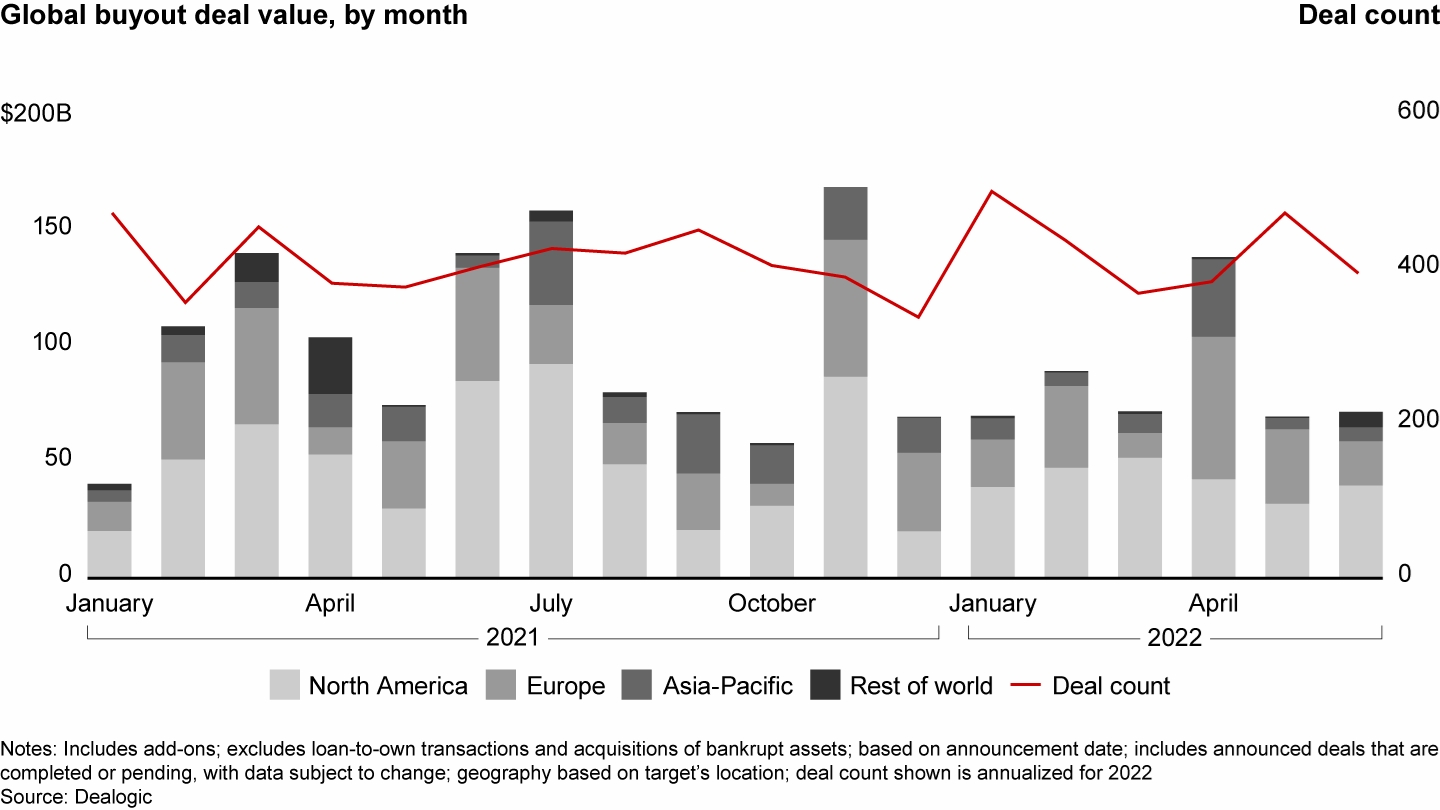Taking stock: Bain & Company's PE Midyear report

Private Equity Report Midyear 2022: First-half deal value was strong, but inflationary pressures are starting to hit home
Inflation topping 9%. Skidding stock markets. Sharply rising interest rates. After the private equity (PE) industry’s past 18 months of record-breaking performance, the next 18 are shaping up to be considerably more challenging.
Our crystal ball is as cloudy as anybody else’s, and any number of factors could scramble the outlook—the war in Ukraine and election-year politics, to name just two. But signs suggest that we are approaching the end of the business cycle, and at midyear, we’re already seeing a slowdown in private markets.
Smart investors would be wise to pay attention to the duration of inflationary spikes over time. Looking at the pattern since 1956, a sharp rise in consumer prices triggers a recession (either because rising prices quash demand or the Federal Reserve does so with rate increases), which then brings the inflation rate back down again. This is in no way a forecast, and there’s no guarantee the pattern will repeat in the current cycle. But if we take the median timeline of these events and apply it today, the current inflation spike could precipitate a recession that starts in September, peaks in October, and then drops back to the long-term trend by September 2023 (see Figure 1).
Figure 1a: Inflation cycles have historically been sharp and short, with rising prices interrupted by recession

Figure 1b: From start to finish, inflation events tend to last about 30 months

The simple math suggests that if firms aren’t already running inflation and recession scenarios against the companies they own or are looking to buy, they’re courting trouble. An industry that has never had to cope with surging inflation before is suddenly getting a crash course in how to manage through it.
The good news is that inflation-recession cycles can be relatively short lived. And the long-term outlook for private equity remains as strong as ever. Limited partners (LPs) have consistently signaled their intent to maintain or increase PE allocations. They remain confident in the fact that PE returns outpace other asset classes. With $3.6 trillion in dry powder generating fees, general partners (GPs) are well positioned to ride out a downturn and prepare for the recovery (see Figure 2). And that can spell opportunity: Deals done coming out of recessions tend to deliver strong returns, something both GPs and LPs learned in the wake of the global financial crisis.
Figure 2: Ample dry powder puts private equity in good stead to weather a downturn

In the short-term, however, it’s likely to get choppy. Here’s a look at what’s in the first-half data.
Investments
Globally, private equity generated $512 billion in buyout deal value during the first half of 2022, putting it on pace to produce the second-highest annual total ever (behind 2021’s all-time record). The 18-month total of $1.7 trillion is by far the strongest year and a half in the industry’s history (see Figure 3). Average deal size remained close to $1 billion in the first half, and deal count was robust.
Figure 3a: The deal market started strong but will have difficulty maintaining momentum in the year’s second half

Figure 3b: Monthly comparisons

Yet as we shift into the year’s second half, activity is slowing down. Deal pipelines in many sectors are softening, in technology especially, and debt is becoming more expensive. Facing losses on loans committed before the slowdown, banks are asking a lot more questions about a company’s exposure to inflation and rising rates, making it harder to close transactions. There’s always a lag in private mark-to-market reporting, but indications are that private multiples are heading lower, taking their cue from the recent slide in public valuations. That’s amplifying uncertainty (always a bad word when it comes to getting deals done), causing buyers and sellers to have increasing trouble aligning on price as buyers look for slack multiples and sellers wait for a better time to sell.
Uncertainty around inflation and technology valuations should have the most impact on US and tech investors since they have led the market’s recent surge. Europe is less sensitive to tech trends, but the continent faces its own brew of uncertainty, including inflation concerns and disruption associated with the war in Ukraine, particularly in energy markets. Asia is a mixed bag. Covid-19–related shutdowns in China, the largest PE market in the region, have roiled deal markets. Yet other markets, such as South Korea and Japan, are holding up well so far.
Click here to read the rest of Bain’s midyear private equity report, which also looks at exits, fund-raising and what investors can do to proactively anticipate change and get ahead of it.